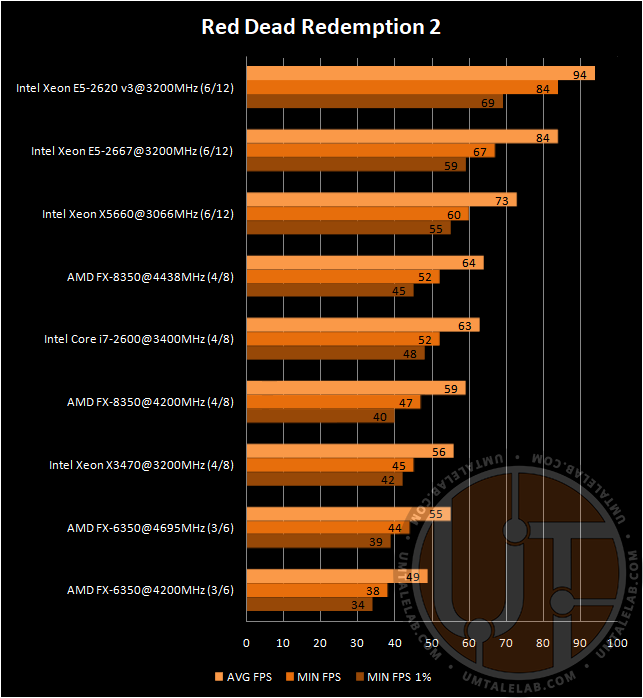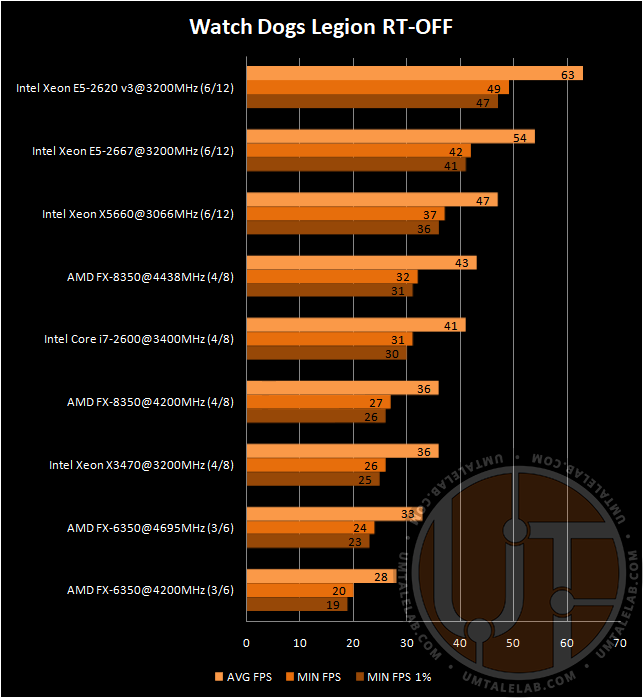
The time of processors based on the Intel Sandy Bridge architecture is gradually coming to an end. Games are getting bigger and more demanding, also due to the release of new generation consoles. A low IPC, low frequencies, and a limited number of supported instructions no longer allow 32nm chips to maintain an acceptable performance level. But what if there are more than four cores? Can, for example, a 6-core, 12-thread chip based on the same architecture show a decent frame rate and demonstrate a confident superiority over the classic Core i7-2600 CPU belonging to the same family? Let’s find it out.
Processor
The Xeon E5-2667, one of the highest performing examples of the 6-core Sandy Bridge-EP processor, got into our test lab. Only the E5-1650 and E5-1660 chips can be faster than it, but their cost is several times higher than the price of our hero, so that’s a completely different story.
Let’s take a look at the CPU itself:


The marking of our test Xeon E5-2667 is SR0KP; the chip is made in Costa Rica, its base frequency is 2900 MHz, and the TDP is set at around 130 watts. This is a decent result, so if you still decide to buy such a hot CPU, try to equip it with an appropriate cooling system.




The E5-2667 processor is based on a 32nm, 6-core, 12-thread variation of the Sandy Bridge-EP die. This chip is designed for installation in motherboards with an LGA 2011 connector, its base frequency is 2900 MHz, however, using Turbo Boost technology, it can increase significantly: 3500 MHz for one core and 3200 MHz for all 6 cores, 12 threads.
The Xeon E5-2667 has 256KB L2 cache per core and a total 15MB L3 cache. The speed of the memory controller built into the processor in the E5-2667 is associated with the frequency of the cores (the L3 cache also works on it) and is always equal to their frequency, the maximum RAM frequency is limited by a four-channel DDR3-1333MHz controller.
In addition to all the above characteristics, it should be noted that the processor has SSE4.2 and AVX instructions that are so necessary for the realities of 2022. This feature will help avid gamers to launch almost any novelty of this year without any problems. But whether the Xeon E5-2667 will cope with these very new products is another question, the answer to which you will find below.
Test setup and software
Test setup
- Processors Intel — Xeon X3470, Core i7-2600, Xeon X5660, Xeon E5-2667, Xeon E5-2620 v3;
- Processors AMD — FX-8350, FX-6350;
- CPU cooling — Cooler Master Hyper 212 Black Edition (RR-212S-20PK-R1);
- RAM for LGA 1155/1156 — 4 x 8GB HyperX Genesis Na’Vi Edition (KHX16C9C2K2/8) sticks, totaling 32GB;
- RAM for LGA 1366 — 3 x 8GB HyperX Genesis Na’Vi Edition (KHX16C9C2K2/8) sticks, totaling 24GB;
- RAM for LGA 2011 — 4 x 8GB Micron MT36JSF1G72PZ-1G4M1HF sticks, totaling 32GB;
- RAM for LGA 2011 v3 — 4 x 4GB G.SKILL DDR4 F4-2400C15S-4GNT sticks, totaling 16GB;
- RAM for AM3+ — 4 x 8GB HyperX Genesis Na’Vi Edition (KHX16C9C2K2/8) sticks, totaling 32GB;
- Motherboard LGA 1156 — DELL OptiPlex 980 (0D441T, mod-BIOS);
- Motherboard LGA 1155 — Gigabyte GA-Z68P-DS3 (rev. 2.0);
- Motherboard LGA 1366 — DELL T3500 (09KPNV);
- Motherboard LGA 2011 — DELL T3610 (09M8Y8);
- Motherboard LGA 2011 v3 — Kllisre X99-D8 (AD12) with modified BIOS (Unlock Turbo Boost, as well as unlocked the ability to control timings);
- Motherboard AM3+ — ASUS M5A97 LE R2.0;
- Видеокарта — KFA2 GeForce RTX 2060 SUPER 8GB (~1950/14816MHz, Power Limit 112%);
- SSD — KINGSTON SUV400S37240G 240,0 GB (Windows 10 + Games) + KINGSTON SUV400S37400G 400,0 GB (Games);
- Power supply — Chieftec GPS-1250C.
Software
- OS: Windows 10 x64 with the latest updates for August 2022;
- Graphics card drivers: NVIDIA GeForce 516.94 WHQL;
- Additional software for measuring FPS: MSI Afterburner 4.6.4;
- Games: testing was conducted on current versions of games as of August 2022;
- Games settings: testing was conducted at the highest possible graphics settings in 720p resolution.
Test processor settings
- Processors Intel:
- Core i7-2600@3400MHz, Dual-Channel DDR3@1866MHz (DDR3 timings 10-11-11-26, DDR3 voltage 1.550v);
- Xeon X3470@3200MHz, Dual-Channel DDR3@1333MHz;
- Xeon X5660@3066MHz, Triple-Channel DDR3@1333MHz;
- Xeon E5-2667@3200MHz, Quad-Channel DDR3@1333MHz;
- Xeon E5-2620 v3@3200MHz, Quad-Channel DDR4@1866MHz (DDR4 timings 10-10-10-24).
- Processors AMD:
- FX-6350@4200MHz, CPU-NB@2200MHz, Dual-Channel DDR3@1866MHz;
- FX-6350@4595MHz, CPU-NB@2608MHz, Dual-Channel DDR3@2086MHz (CPU Core voltage — 1.440v, CPU-NB voltage — 1.375v, DDR3 voltage — 1.660v);
- FX-8350@4200MHz, CPU-NB@2200MHz, Dual-Channel DDR3@1866MHz;
- FX-8350@4434MHz, CPU-NB@2608MHz, Dual-Channel DDR3@2086MHz (DDR3 timings 11-12-12-30, CPU Core voltage — 1.416v, CPU-NB voltage — 1.375v, DDR3 voltage — 1.660v).
You can learn more about almost all the subjects from our full-fledged materials, or by looking at the blogs section, where small notes fall.
Separately, let me remind you of the processor testing methodology: each game was run five times, then the average frame rate among five runs was selected and it was recorded in the final results. Also, let me remind you again: all the games were installed on the SSD.
Test results
A few words about the features of this material: in addition to the results of the E5-2667 chip, I will also comment on the performance of other processors, since the latter are tested for the first time in actual games in 2022. In my opinion, it will be extremely interesting to examine the performance of the same AMD FX-8350 and Intel Core i7-2600, after which it will be extremely interesting to compare them with the hero of this material. However, subjectively, the most interesting confrontation will unfold between Xeon E5-2667 and Xeon E5-2620 v3. Both CPUs are six-core, operate at the same frequency and work with quad-channel memory, but they differ architecturally: Sandy Bridge and Haswell, respectively.
Assassins Creed Valhalla

In the first game from our new “Assassins Creed Valhalla” test package, the performance of the E5-2667 chip is a little alarming: the six-core Sandy Bridge is slightly inferior to the boosted AMD FX-8350 and disastrously behind its older brother, the E5-2620 v3. In addition, the gap from the X5660 cannot be called critical: the old Westmere performed quite successfully in the current part of the Assassins franchise.
However, it should be noted that all the test subjects, including the 6-thread FX-6350, were able to successfully cope with “Assassins Creed Valhalla” and provide a minimally comfortable FPS.
Battlefield 2042

Ray Tracing – ON
Battlefield 2042 is not well optimized, which is why a large fleet of components was left out of work. A similar fate awaits most of the tested processors: the only chip that can comfortably play in network mode with activated ray tracing is the Xeon E5-2620 v3. Unfortunately, neither the hero of this material E5-2667 nor the rest of the subjects were able to demonstrate sane results.
Ray Tracing – OFF
However, one has only to turn off the notorious ray tracing and everything changes dramatically: the E5-2667 demonstrates quite confident 63 FPS and even the old, overclocked FX-8350 reaches 59 frames per second. That can not be said about the stock version of the FX-8350 and Core i7-2600. Unfortunately, their performance is at a very low level.
Also, I would like to note the Xeon X5660. In general, the owners of this chip have the opportunity to evaluate the BF2042, but, alas, one cannot count on a comfortable and, most importantly, stable FPS on all network mode maps.
Cyberpunk 2077

Ray Tracing – ON
Cyberpunk 2077 is a single-player game, so the requirements for high frame rates are slightly lower in this case. This is why the E5-2667 is a pretty good choice for this project with ray tracing enabled. The same judgments apply to the X5660, i7-2600, and the overclocked FX-8350. What can not be said about the base frequencies of the AMD chip: alas, the stock 8350 managed to lose even to the ancient Xeon X3470.
Ray Tracing – OFF
Without ray tracing, almost all tested processors coped with Cyberpunk 2077. And the Xeon E5-2667 showed quite a good result at 72 frames per second. Nevertheless, to be frank, it could not compete with the six-core Haswell: the E5-2620 v3 plays in its weight category.
If we talk about comparing the FX-8350 with the Core i7-2600, then in Cyberpunk 2077 the top representative of the LGA1155 platform confidently outperforms the overclocked version of its competitor and shows a much higher result compared to the stock FX.
Destiny 2

As we have already mentioned in many past materials, Destiny 2 is a multiplayer game that has blocked the ability to use third-party overlays, which means that it does not support MSI Afterburner. Thus, it is not possible to take accurate indicators in it. However, thanks to the Steam in-game counter, we still managed to get more or less representative data.
Looking at the performance chart we got, it’s pretty clear that Bungie still hasn’t made their game engine work with more than six threads, which translates into the actual lead of the E5-2620 v3 overclocked to 4695MHz FX-6350 and boosted FX- 8350. The Xeon E5-2667 only came in fourth with 88 FPS. However, it is worth noting that thanks to a capacious cache, it still managed to significantly overtake the higher-frequency Core i7-2600 chip.
Elden Ring

The latest (at the moment) creation of Japanese game designer Hidetaka Miyazaki – Elden Ring disappointed. Hardcore RPG optimization is at a very mediocre level and in fact, none of the tested processors could demonstrate a comfortable level of performance. This is especially true of the Xeon E5-2667, the gameplay on which was replete with unpleasant microfreezes and unstable FPS. But the overclocked FX-8350, on the contrary, pleased me. Although it did not reach the average frame rate per second E5-2667, but the minimum FPS on it turned out to be much better. In addition, FX provided a low but fairly stable FPS.
Far Cry 6

Ray Tracing — ON
Another example of bad optimization is Far Cry 6. The game can’t work with multi-threaded processors, which is why even the Xeon E5-2620 v3 is not able to show a decent result with ray tracing enabled. The Xeon E5-2667 is in fourth place with 47 fps. The six-core Sandy Bridge lost not only to the overclocked FX-8350 but also to the FX-6350. And the stock version of AMD’s 8-thread processor demonstrated (!) the same results as the hero of this material while outperforming the Core i7-2600.
To be honest, the E5-2667 was able to show a higher FPS than the Core i7 only thanks to almost twice as much L3 cache.
Ray Tracing — OFF
The game shows similar results with ray tracing disabled. FPS has become much higher, but the balance of power among the processors has not changed much.
Far Cry 6 is already a relatively old game, so it’s probably not worth waiting for patches that will improve the situation. Thus, if for some reason you are a fan of the sixth part of the popular franchise from Ubisoft, then you are better off choosing a more modern chip with high performance per core, like Intel Alder Lake or AMD Zen 3.
Marvel’s Spider-Man Remastered

Ray Tracing — OFF
How do you like these results? None of the tested processors, except for the E5-2620v3, could run the former SONY exclusive “Marvel’s Spider-Man Remastered” with ray tracing activated! It is quite possible that the situation will change with future patches, but at the end of August 2022, we have what we have.
In my opinion, the AVX2 extension, which only supports six-core Haswell, played a key role, but we do not have exact information. However, just because the E5-2620v3 was still able to run “Marvel’s Spider-Man Remastered” with ray tracing doesn’t mean that this chip can handle it. FPS is quite low and often stays at 46. Thus, in theory, you can predict the behavior of weaker processors from this test, and the situation for them would not be rosy at all.
Ray Tracing — OFF
Fortunately, disabling ray tracing allowed us to successfully test the game on all test subjects, including processors without AVX support of the first version. Let’s start with the fact that the game cannot rationally use more than six threads, which leads to a situation in which the FX-6350 overclocked to 4695 MHz was able to bypass the E5-2667, and its base version, running at 4200 MHz, provided slightly higher performance than the Core i7- 2600.
The Xeon X5660 and X3470 processors are located on the penultimate and last place, respectively. This is rather strange because, in many previous projects, the 6-core Westmere successfully competed with the 4-core Sandy Bridge thanks to three-channel memory and a 12-MB L3 cache buffer. But it can’t be wrong: the Core i7-2600 did marginally outperform the Xeon X5660 in Marvel’s Spider-Man Remastered.
Marvel’s Guardians of the Galaxy

Ray Tracing — ON
Marvel’s Guardians of the Galaxy uses the power of multi-threaded CPUs much more efficiently, so the E5-2667 looks quite confident here. On average, the chip demonstrates 59 frames per second with rare drops to 46. Our hero is followed by the X5660, which is literally breathing down the back of the Core i7-2600. The latter, by the way, was able to bypass the FX-8350 overclocked to 4438 MHz, which is pretty good. The rest of the test subjects were unable to provide a comfortable level of performance with ray tracing activated. However, there is something to be surprised here too: the Xeon X3470 processor managed to bypass the stock version of the FX-8350, which is quite unexpected.
Ray Tracing — OFF
Disabling ray tracing makes life easier for virtually all processors from this test. The only exception, perhaps, is the stock FX-6350. Frankly speaking, the passage of “Guardians of the Galaxy” on this chip will not allow you to fully enjoy a solid project. However, do not forget about overclocking: after it, the FX-6350 was able to bypass the X3470 and the stock FX-8350. The rest of the CPUs demonstrate roughly similar results, and the E5-2620 v3 is again beyond the reach of the E5-2667.
Saints Row [2022]

Ray Tracing — ON
The above chart shocked me a little and I don’t even know where to start…
The reboot of the once legendary Saints Row franchise was released just a few days ago (at the time of testing) and the optimization in this project is at an extremely mediocre level. With ray tracing enabled, only the Xeon E5-2620 v3 shows a relatively stable and high frame rate. AMD FX chips are not capable of producing decent results: don’t let the average FPS fool you, because the game freezes incredibly on both the overclocked FX-8350 and the stock one. And I am 99% sure that this problem is not related to the AMD Bulldozer CPU architecture, because much more complex and well-developed projects work quite well on the FX-8350.
Considering all of the above, the Xeon E5-2667 performed well: the minimum FPS was around 44, thanks to which it was able to beat the X5660 and Core i7-2600 quite a bit, but at the same time, which is not surprising, the E5-2667 was disastrously inferior to the E5- 2620v3. The six-core Haswell once again proved its undisputed leadership in the ultimate FPS.
Ray Tracing — OFF
Deactivating ray tracing made it possible to squeeze a little more performance out of all CPUs, but again, this did not help AMD FX chips – friezes did not disappear anywhere.
Red Dead Redemption 2

Red Dead Redemption 2 is exactly the game that almost fully reveals the potential of the Xeon E5-2667 chip. The protagonist of this article easily dealt with absolutely all his competitors, losing only to the more technologically advanced E5-2620 v3. The performance of the six-core Sandy Bridge is really amazing: it was not difficult for him to provide a minimum FPS of 67, which is an amazing result for such a well-developed and graphically heavy game as RDR2!
In fairness, it should be noted that almost all tested processors, with the exception of the stock FX-6350, coped with Red Dead Redemption 2. However, it is worth mentioning the very confident performance of the Core i7-2600. The 4-core, 8-thread Sandy Bridge provides a very decent frame rate and competes on equal terms with the overclocked FX-8350.
In addition, if you look closely at the chart, you will notice how linear (about +10 FPS) each new generation of 6-core Intel adds in performance.
Watch Dogs Legion

Ray Tracing — ON
The last and probably the heaviest game from our new set of test projects is Watch Dogs Legion. Here, with ray tracing enabled, even the Xeon E5-2620 v3 cannot provide its owner with a comfortable frame rate. What can we say about the weaker E5-2667: the six-core Sandy Bridge averages 42 frames per second, and the minimum FPS on it dropped to 34. This is an extremely low result. However, the rest of the subjects performed significantly worse.
Ray Tracing — OFF
Without ray tracing, the performance of all processors increases significantly and the previously inconspicuous E5-2667 becomes a very good choice for a relatively comfortable game in the third part of Watch Dogs. Even the old X5660 allows you to evaluate the current Watch Dogs Legion at maximum settings.
Conclusion
Unfortunately, in the realities of 2022, the Intel Xeon E5-2667 chip no longer looks as attractive as before. With ray tracing enabled, he was unable to demonstrate acceptable FPS in almost any game. In the classic mode, without the notorious ray tracing, the results of the protagonist of this article look more solid. However, even so, in about half of the projects tested, he failed to gain a foothold on the bar of 60 frames per second.
Of course, non-demanding gamers can reduce the quality of graphics, due to which, in some cases. This will significantly increase the final performance. But such an option, in my opinion, makes sense only with a relatively weak graphics card of the GTX 1060/RX 470 level. If you own an adapter like RTX 2060 SUPER, RX 5700, or better, then you don’t want to lower the visual effects settings at all.
Based on all of the above, it is extremely difficult to recommend the Xeon E5-2667 processor for comfortable gameplay in current titles. Actually, it’s much more logical to turn your attention to the E5-2620 v3, which demonstrates a confident advantage over the six-core Sandy Bridge and is often able to deliver the very necessary 60 frames per second for every gamer.
As for the confrontation between the 4-core Sandy Bridge and the 6-core one, the answer is unequivocal: the server Xeon E5-2667 is indeed much more productive than its desktop counterpart in the Core i7-2600 architecture. And this is no wonder. Many AAA projects (sorry, not all of them) have long since learned to use more than six threads. And games that are technically a decade old are getting a significant performance boost thanks to the E5-2667’s larger L3 cache.
Thank you for your attention!







































